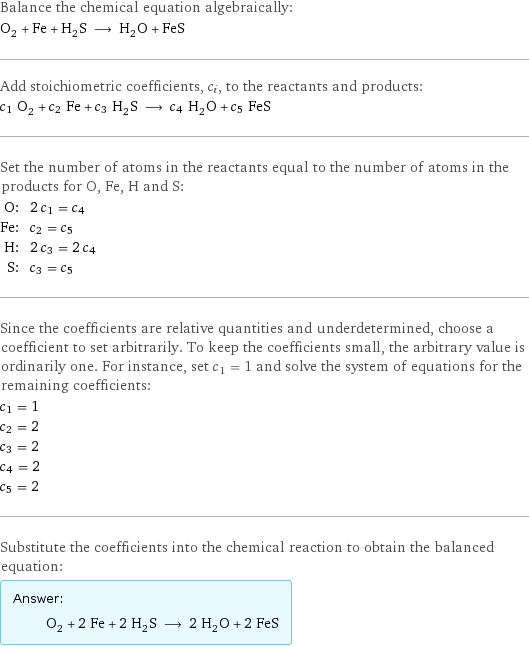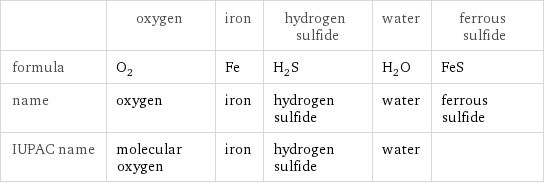Input interpretation

O_2 oxygen + Fe iron + H_2S hydrogen sulfide ⟶ H_2O water + FeS ferrous sulfide
Balanced equation

Balance the chemical equation algebraically: O_2 + Fe + H_2S ⟶ H_2O + FeS Add stoichiometric coefficients, c_i, to the reactants and products: c_1 O_2 + c_2 Fe + c_3 H_2S ⟶ c_4 H_2O + c_5 FeS Set the number of atoms in the reactants equal to the number of atoms in the products for O, Fe, H and S: O: | 2 c_1 = c_4 Fe: | c_2 = c_5 H: | 2 c_3 = 2 c_4 S: | c_3 = c_5 Since the coefficients are relative quantities and underdetermined, choose a coefficient to set arbitrarily. To keep the coefficients small, the arbitrary value is ordinarily one. For instance, set c_1 = 1 and solve the system of equations for the remaining coefficients: c_1 = 1 c_2 = 2 c_3 = 2 c_4 = 2 c_5 = 2 Substitute the coefficients into the chemical reaction to obtain the balanced equation: Answer: | | O_2 + 2 Fe + 2 H_2S ⟶ 2 H_2O + 2 FeS
Structures

+ + ⟶ +
Names

oxygen + iron + hydrogen sulfide ⟶ water + ferrous sulfide
Reaction thermodynamics
Enthalpy

| oxygen | iron | hydrogen sulfide | water | ferrous sulfide molecular enthalpy | 0 kJ/mol | 0 kJ/mol | -20.6 kJ/mol | -285.8 kJ/mol | -100 kJ/mol total enthalpy | 0 kJ/mol | 0 kJ/mol | -41.2 kJ/mol | -571.7 kJ/mol | -200 kJ/mol | H_initial = -41.2 kJ/mol | | | H_final = -771.7 kJ/mol | ΔH_rxn^0 | -771.7 kJ/mol - -41.2 kJ/mol = -730.5 kJ/mol (exothermic) | | | |
Entropy

| oxygen | iron | hydrogen sulfide | water | ferrous sulfide molecular entropy | 205 J/(mol K) | 27 J/(mol K) | 206 J/(mol K) | 69.91 J/(mol K) | 67 J/(mol K) total entropy | 205 J/(mol K) | 54 J/(mol K) | 412 J/(mol K) | 139.8 J/(mol K) | 134 J/(mol K) | S_initial = 671 J/(mol K) | | | S_final = 273.8 J/(mol K) | ΔS_rxn^0 | 273.8 J/(mol K) - 671 J/(mol K) = -397.2 J/(mol K) (exoentropic) | | | |
Equilibrium constant
![Construct the equilibrium constant, K, expression for: O_2 + Fe + H_2S ⟶ H_2O + FeS Plan: • Balance the chemical equation. • Determine the stoichiometric numbers. • Assemble the activity expression for each chemical species. • Use the activity expressions to build the equilibrium constant expression. Write the balanced chemical equation: O_2 + 2 Fe + 2 H_2S ⟶ 2 H_2O + 2 FeS Assign stoichiometric numbers, ν_i, using the stoichiometric coefficients, c_i, from the balanced chemical equation in the following manner: ν_i = -c_i for reactants and ν_i = c_i for products: chemical species | c_i | ν_i O_2 | 1 | -1 Fe | 2 | -2 H_2S | 2 | -2 H_2O | 2 | 2 FeS | 2 | 2 Assemble the activity expressions accounting for the state of matter and ν_i: chemical species | c_i | ν_i | activity expression O_2 | 1 | -1 | ([O2])^(-1) Fe | 2 | -2 | ([Fe])^(-2) H_2S | 2 | -2 | ([H2S])^(-2) H_2O | 2 | 2 | ([H2O])^2 FeS | 2 | 2 | ([FeS])^2 The equilibrium constant symbol in the concentration basis is: K_c Mulitply the activity expressions to arrive at the K_c expression: Answer: | | K_c = ([O2])^(-1) ([Fe])^(-2) ([H2S])^(-2) ([H2O])^2 ([FeS])^2 = (([H2O])^2 ([FeS])^2)/([O2] ([Fe])^2 ([H2S])^2)](../image_source/096f66aecee6413f3a71f7fe336999ca.png)
Construct the equilibrium constant, K, expression for: O_2 + Fe + H_2S ⟶ H_2O + FeS Plan: • Balance the chemical equation. • Determine the stoichiometric numbers. • Assemble the activity expression for each chemical species. • Use the activity expressions to build the equilibrium constant expression. Write the balanced chemical equation: O_2 + 2 Fe + 2 H_2S ⟶ 2 H_2O + 2 FeS Assign stoichiometric numbers, ν_i, using the stoichiometric coefficients, c_i, from the balanced chemical equation in the following manner: ν_i = -c_i for reactants and ν_i = c_i for products: chemical species | c_i | ν_i O_2 | 1 | -1 Fe | 2 | -2 H_2S | 2 | -2 H_2O | 2 | 2 FeS | 2 | 2 Assemble the activity expressions accounting for the state of matter and ν_i: chemical species | c_i | ν_i | activity expression O_2 | 1 | -1 | ([O2])^(-1) Fe | 2 | -2 | ([Fe])^(-2) H_2S | 2 | -2 | ([H2S])^(-2) H_2O | 2 | 2 | ([H2O])^2 FeS | 2 | 2 | ([FeS])^2 The equilibrium constant symbol in the concentration basis is: K_c Mulitply the activity expressions to arrive at the K_c expression: Answer: | | K_c = ([O2])^(-1) ([Fe])^(-2) ([H2S])^(-2) ([H2O])^2 ([FeS])^2 = (([H2O])^2 ([FeS])^2)/([O2] ([Fe])^2 ([H2S])^2)
Rate of reaction
![Construct the rate of reaction expression for: O_2 + Fe + H_2S ⟶ H_2O + FeS Plan: • Balance the chemical equation. • Determine the stoichiometric numbers. • Assemble the rate term for each chemical species. • Write the rate of reaction expression. Write the balanced chemical equation: O_2 + 2 Fe + 2 H_2S ⟶ 2 H_2O + 2 FeS Assign stoichiometric numbers, ν_i, using the stoichiometric coefficients, c_i, from the balanced chemical equation in the following manner: ν_i = -c_i for reactants and ν_i = c_i for products: chemical species | c_i | ν_i O_2 | 1 | -1 Fe | 2 | -2 H_2S | 2 | -2 H_2O | 2 | 2 FeS | 2 | 2 The rate term for each chemical species, B_i, is 1/ν_i(Δ[B_i])/(Δt) where [B_i] is the amount concentration and t is time: chemical species | c_i | ν_i | rate term O_2 | 1 | -1 | -(Δ[O2])/(Δt) Fe | 2 | -2 | -1/2 (Δ[Fe])/(Δt) H_2S | 2 | -2 | -1/2 (Δ[H2S])/(Δt) H_2O | 2 | 2 | 1/2 (Δ[H2O])/(Δt) FeS | 2 | 2 | 1/2 (Δ[FeS])/(Δt) (for infinitesimal rate of change, replace Δ with d) Set the rate terms equal to each other to arrive at the rate expression: Answer: | | rate = -(Δ[O2])/(Δt) = -1/2 (Δ[Fe])/(Δt) = -1/2 (Δ[H2S])/(Δt) = 1/2 (Δ[H2O])/(Δt) = 1/2 (Δ[FeS])/(Δt) (assuming constant volume and no accumulation of intermediates or side products)](../image_source/2d3227011a006a6a867a1f47c55db8f1.png)
Construct the rate of reaction expression for: O_2 + Fe + H_2S ⟶ H_2O + FeS Plan: • Balance the chemical equation. • Determine the stoichiometric numbers. • Assemble the rate term for each chemical species. • Write the rate of reaction expression. Write the balanced chemical equation: O_2 + 2 Fe + 2 H_2S ⟶ 2 H_2O + 2 FeS Assign stoichiometric numbers, ν_i, using the stoichiometric coefficients, c_i, from the balanced chemical equation in the following manner: ν_i = -c_i for reactants and ν_i = c_i for products: chemical species | c_i | ν_i O_2 | 1 | -1 Fe | 2 | -2 H_2S | 2 | -2 H_2O | 2 | 2 FeS | 2 | 2 The rate term for each chemical species, B_i, is 1/ν_i(Δ[B_i])/(Δt) where [B_i] is the amount concentration and t is time: chemical species | c_i | ν_i | rate term O_2 | 1 | -1 | -(Δ[O2])/(Δt) Fe | 2 | -2 | -1/2 (Δ[Fe])/(Δt) H_2S | 2 | -2 | -1/2 (Δ[H2S])/(Δt) H_2O | 2 | 2 | 1/2 (Δ[H2O])/(Δt) FeS | 2 | 2 | 1/2 (Δ[FeS])/(Δt) (for infinitesimal rate of change, replace Δ with d) Set the rate terms equal to each other to arrive at the rate expression: Answer: | | rate = -(Δ[O2])/(Δt) = -1/2 (Δ[Fe])/(Δt) = -1/2 (Δ[H2S])/(Δt) = 1/2 (Δ[H2O])/(Δt) = 1/2 (Δ[FeS])/(Δt) (assuming constant volume and no accumulation of intermediates or side products)
Chemical names and formulas

| oxygen | iron | hydrogen sulfide | water | ferrous sulfide formula | O_2 | Fe | H_2S | H_2O | FeS name | oxygen | iron | hydrogen sulfide | water | ferrous sulfide IUPAC name | molecular oxygen | iron | hydrogen sulfide | water |
Substance properties

| oxygen | iron | hydrogen sulfide | water | ferrous sulfide molar mass | 31.998 g/mol | 55.845 g/mol | 34.08 g/mol | 18.015 g/mol | 87.9 g/mol phase | gas (at STP) | solid (at STP) | gas (at STP) | liquid (at STP) | solid (at STP) melting point | -218 °C | 1535 °C | -85 °C | 0 °C | 1195 °C boiling point | -183 °C | 2750 °C | -60 °C | 99.9839 °C | density | 0.001429 g/cm^3 (at 0 °C) | 7.874 g/cm^3 | 0.001393 g/cm^3 (at 25 °C) | 1 g/cm^3 | 4.84 g/cm^3 solubility in water | | insoluble | | | insoluble surface tension | 0.01347 N/m | | | 0.0728 N/m | dynamic viscosity | 2.055×10^-5 Pa s (at 25 °C) | | 1.239×10^-5 Pa s (at 25 °C) | 8.9×10^-4 Pa s (at 25 °C) | 0.00343 Pa s (at 1250 °C) odor | odorless | | | odorless |
Units
